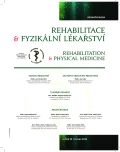Postural Stability during Standing in Subjects with L5 Radicular Syndrome
Authors:
Z. Svoboda 1; H. Bednáříková 1; M. Janura 1; E. Zemková 2
Authors‘ workplace:
Katedra přírodních věd v kinantropologii, Fakulta tělesné kultury, Univerzita Palackého v Olomouci
vedoucí katedry prof. RNDr. M. Janura, Dr.
1; Katedra športovej kinantropológie, Fakulta telesnej výchovy a športu, Univerzita Komenského, Bratislava
vedúcí katedry doc. MUDr. J. Lipková, Ph. D.
2
Published in:
Rehabil. fyz. Lék., 23, 2016, No. 2, pp. 74-78.
Category:
Original Papers
Overview
The number of scientific studies dealing with the postural stability in people with non-specific low back pain; however research of groups with specific diagnoses relating to similar symptoms is limited. The objective of this study was to assess the effect of L5 root syndrome on the postural stability during standing. The observed group consisted of 10 patients aged 41.1 ± 9.3 years diagnosed with L5 root syndrome and 12 healthy people aged 38.7 ± 11.2 years who formed the control group. Basic examination, which included visual inspection of pelvis and spine, spinal functional tests and testing of the deep stabilisation system, was carried out before the measurement started; research group was also tested for the root symptoms. Postural stability during standing with eyes open, eyes closed and standing on a narrow stand was assessed with the use of the Kistler force plate. The COP velocity in the experimental group was lower compared with the control group, which indicates a better level of postural stability. The COP velocity was higher on the affected side within the L5 root syndrome group and in non-dominant limb in healthy subjects. The results of the study showed that middle-aged people with root syndrome do not have impaired postural stability and also differences between limbs in the COP velocity are at a similar level as in the normal population.
Keywords:
intervertebral disc, force plates, centre of pressure, balance
Sources
1. ANKER, L. C., WEERDESTEYN, V., VAN NES, I. J., NIENHUIS, B., STRAATMAN, H., GEURTS, A. C.: The relation between postural stability and weight distribution in healthy subjects. Gait Posture, roč. 27, 2008, č. 3, s. 471-477.
2. BLASZCZYK, J. W., BECK, M., SADOWSKA, D.: Assessment of postural stability in young healthy subjects based on directional features of posturographic data: Vision and gender effects. Acta Neurobiol. Exp., roč. 74, 2014, č. 4, s. 433-442.
3. BLASZCZYK, J. W., PRINCE, F., RAICHE, M., HÉBERT, R.: Effect of ageing and vision on limb load asymmetry during quiet stance. J. Biomech., roč. 33, 2000, č. 10, s. 1243-1248.
4. BRUMAGNE, S., CORDO, P., VERSCHUEREN, S.: Proprio-ceptive weighting changes in persons with low back pain and elderly persons during upright standing. Neurosci. Lett., roč. 366, 2004, č. 1, s. 63-66.
5. DVOŘÁK, R.: Základy kinezioterapie. Olomouc, Univerzita Palackého, 2007.
6. GILL, K. P., CALLAGHAN, M. J.: The measurement of lumbar proprioception in individuals with and without low back pain. Spine, roč. 23, 1998, č. 3, s. 371-377.
7. GROUIOS, G., HATZITAKI, V., KOLLIAS, N., KOIDOU, I.: Investigating the stabilising and mobilising features of footedness. Laterality, roč. 14, 2009, č. 4, s. 362-380.
8. HARRINGE, M. L., HALVORSEN, K., RENSTRÖM, P., WERNER, S.: Postural control measured as the center of pressure excursion in young female gymnasts with low back pain or lower extremity injury. Gait Posture, roč. 28, 2008, č. 1, s. 38-45.
9. HUE, O. et al.: Body weight is a strong predictor of postural stability. Gait Posture, roč. 26, 2007, č. 1, č. 32-38.
10. JO, H. J., SONG, A. Y., LEE, K. J., LEE, D. C., KIM, Y. H., SUNG, P. S.: A kinematic analysis of relative stability of the lower extremities between subjects with and without chronic low back pain. Eur. Spine J., roč. 20, 2011, č. 8, s. 1297–1303.
11. KOVÁČIKOVÁ, Z., SVOBODA, Z., NEUMANNOVÁ, K., BIZOVSKÁ, L., CUBEREK, R., JANURA, M.: Assessment of postural stability in overweight and obese middle-aged women. Acta Gymnica, roč. 44, 2014, č. 3, s. 149-153.
12. MOK, N. W., BRAUER, S. G., HODGES, P. W.: Hip strategy for balance control in quiet standing is reduced in people with low back pain. Spine, roč. 29, 2004, č. 6, s. 107-112.
13. MUEHLBAUER, T., METTLER, C., ROTH, R., GRANACHER, U.: One-leg standing performance and muscle activity: Are there limb differences? J. Appl. Biomech., roč. 30, 2014, č. 3, s. 407-414.
14. PFEIFFER, J.: Neurologie v rehabilitaci. Praha, Grada Publishing, 2007.
15. RUHE, A., FEJER, R. WALKER, B.: Center of pressure excursion as a measure of balance performance in patients with non-specific low back pain compared to healthy controls: A systematic review of the literature. Europ. Spine J., roč. 20, 2011, č. 3, s. 358-368.
16. SALAVATI, M. et al.: Effect of dual-tasking on postural control in subjects with nonspecific low back pain. Spine, roč. 34, 2009, č. 13, s. 1415-1421.
17. SEIDL, Z., OBENBERGER, J.: Neurologie pro studium i praxi (1. vyd.), Praha, Grada Publishing, 2004.
18. VAŘEKA, I.: Posturální stabilita – terminologie a biomechanické principy. Rehabil. fyz. Lék., roč. 9, 2002, č. 4, s. 115-121.
19. VÉLE, F.: Kineziologie posturálního systému. Praha, Karolinum, 1995.
20. VÉLE, F.: Kineziologie. Přehled klinické kineziologie a patokineziologie pro diagnostiku a terapii poruch pohybové soustavy (2. vyd.). Praha, Triton, 2006.
Labels
Physiotherapist, university degree Rehabilitation Sports medicineArticle was published in
Rehabilitation & Physical Medicine

2016 Issue 2
- Hope Awakens with Early Diagnosis of Parkinson's Disease Based on Skin Odor
- Deep stimulation of the globus pallidus improved clinical symptoms in a patient with refractory parkinsonism and genetic mutation
Most read in this issue
- Sacralization of Vertebra L5
- Positioning Chronically Immobile and Terminally-Ill Patients
- Options of Physiotherapy for Patients with Kidney Disease, on Dialysis and after Kidney Transplantation - Overview from Past to Present
- Spectrum, Trends and Approaches in Contemporary Neurorehabilitation
